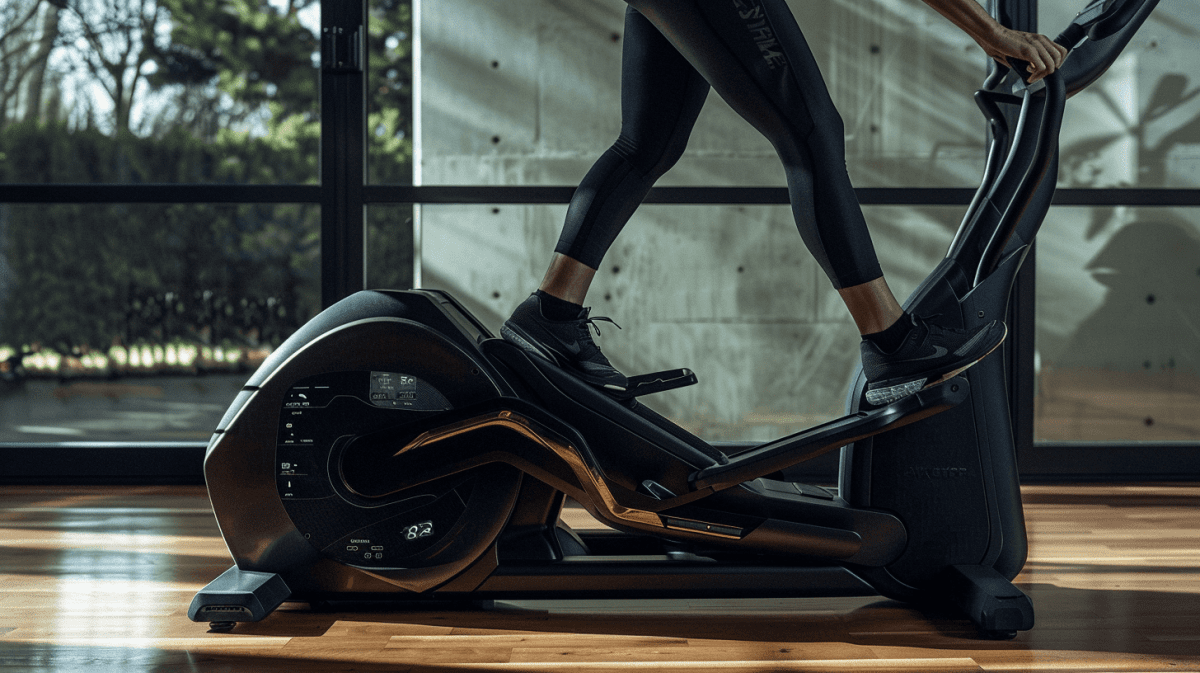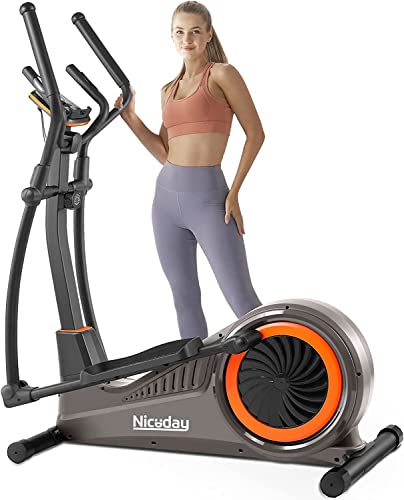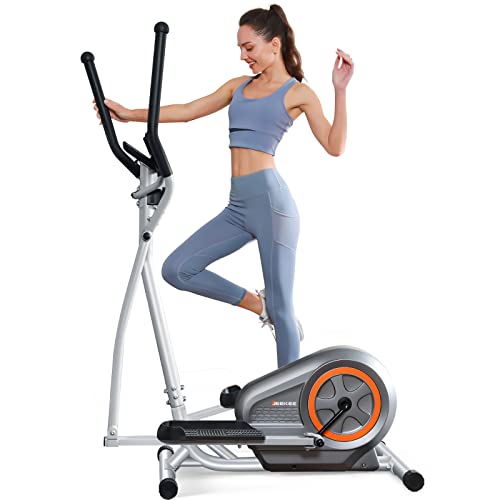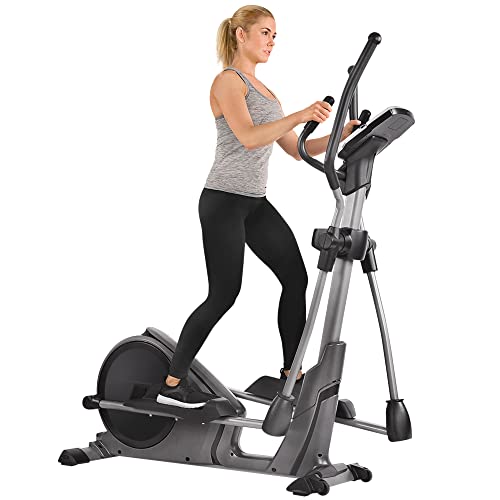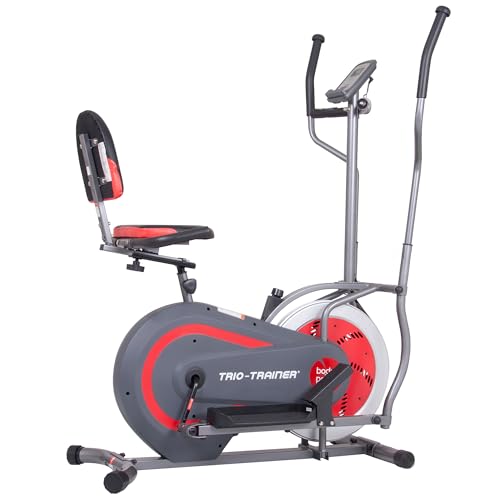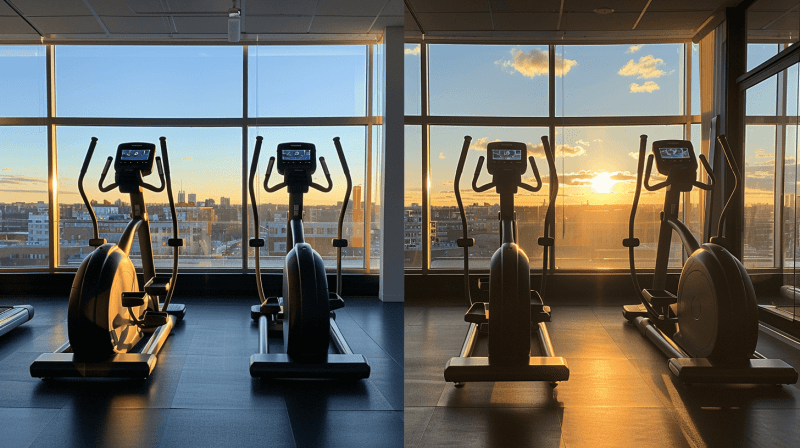While many gym-goers believe the elliptical is a lower-intensity alternative to running, you can actually burn just as many calories on this machine when you use it correctly. The key lies in understanding how to combine proper form, resistance settings, and interval training to maximize your workout efficiency. Whether you're a beginner looking to improve your cardiovascular fitness or an experienced athlete seeking a low-impact cross-training option, mastering the essentials of elliptical training will transform what might seem like a basic exercise into a powerful fat-burning, muscle-strengthening workout that delivers impressive results.
Key Takeaways
-
Maintain proper posture with shoulders back, core engaged, and feet shoulder-width apart while coordinating arm and leg movements.
-
Alternate between high-intensity intervals of 1-2 minutes and recovery periods, adjusting resistance and incline for maximum results.
-
Use moving handles instead of stationary ones to increase calorie burn and engage upper body muscles.
-
Monitor heart rate to stay within 60-80% of maximum, ensuring optimal fat-burning and cardiovascular benefits.
-
Vary workout lengths between 20-60 minutes and incorporate different resistance levels to prevent plateaus and maintain progress.
Proper Form and Posture
When using an elliptical machine, your posture directly impacts workout effectiveness and injury prevention. To maintain proper form, stand tall with your shoulders back, head aligned with your spine, and core muscles engaged throughout the exercise. Keeping your body in this neutral position will help support your weight and maximize the benefits of your workout.
Your feet should be firmly planted on the foot pedals, with your weight distributed evenly between your heel and the ball of your foot. As you push and pull the handles, avoid leaning forward or gripping too tightly, as this is the wrong way to use the machine and can lead to unnecessary strain on your back and shoulders.
The low-impact motion design helps reduce stress on your joints while still providing an effective cardiovascular workout.
Essential tips to help prevent injuries while maintaining correct posture:
- Keep your knees slightly bent, never locked
- Look straight ahead, not down at your feet
- Allow your arms to move naturally with the handles
- Maintain a consistent rhythm without bouncing
If you're experiencing discomfort, consider working with a trainer for corrective exercise guidance to address any form issues. Remember that maintaining proper alignment is vital for both safety and workout efficiency.
Hand and Foot Positioning
Proper form extends beyond basic posture to the specific placement of your hands and feet on the elliptical machine. While this low-impact exercise equipment offers an excellent cardio workout, you'll need to position your body correctly to maximize its benefits and prevent potential injuries.
For ideal hand positioning during your workout, don't lean on the stationary handles, as this reduces both calorie burn and upper body engagement. Instead, grip the moving handles and coordinate your pushing and pulling motions with your leg movements, creating a full-body exercise that increases the overall effectiveness of your physical activity.
Your foot positioning plays a vital role in getting the most out of your elliptical workouts. Place your feet shoulder-width apart and distribute your weight evenly across your entire foot, similar to your natural running stance. As you move through the resistance levels, make sure to roll through your full foot with each stride, avoiding the tendency to rise onto your toes or balls of your feet. This proper lower body alignment helps reduce joint stress while maintaining the machine's low-impact benefits and ensuring a more effective cardiovascular session. Try pedaling backward occasionally to engage your hamstring muscles more effectively during your workout.
Setting the Right Resistance
As you approach the end of your workout, gradually decrease the resistance to allow for proper cool-down and recovery, helping prevent muscle soreness and promoting better circulation. The low-impact design of elliptical machines makes it easier to adjust resistance levels without risking joint strain or injury.
HIIT Training on Ellipticals
HIIT training on ellipticals takes your workout to the next level by maximizing results in less time. This high-intensity interval training approach alternates between intense bursts of activity and brief recovery periods on your elliptical machine, helping you burn more calories and improve cardiovascular fitness more efficiently than steady-state cardio workouts.
To perform an effective HIIT elliptical workout, you'll want to structure your intervals carefully. Start by alternating between 1-2 minutes of high-intensity work, where you'll increase both resistance and incline while maintaining a fast pace, followed by 1-2 minutes of lower-intensity recovery periods. During these cardio machine intervals, you should monitor your heart rate to guarantee you're working at ideal intensity levels for maximum fitness advantages.
Proper form is essential for your elliptical training success. Keep your posture upright and engage your core while using the moving arms to activate multiple muscle groups. Your workout routine should include a proper warm-up before starting the intervals, and you'll want to maintain consistent form throughout the session, even as fatigue sets in. This thorough approach ensures you'll get the most out of your HIIT cardio workout. A 150-pound person can expect to burn approximately 350 calories during a moderate 30-minute elliptical session.
Tracking Your Heart Rate
Maintaining ideal heart rate levels during your elliptical workout guarantees you're getting the most out of your training session. To achieve essential cardiovascular benefits, you'll want to keep your heart rate within 60-80% of your maximum heart rate, which you can calculate by subtracting your age from 220.
You can track your heart rate in two effective ways while using the elliptical. The first option is wearing a heart rate monitor, which provides continuous, real-time feedback about your intensity level. Alternatively, you can manually check your pulse, though this method requires brief pauses in your workout to get accurate readings.
When you're monitoring your heart rate, you can make adjustments to stay within your target heart rate zone. If you need to increase your heart rate, try raising the resistance or incline on your elliptical. Conversely, if your heart rate is too high, lower these settings until you reach your desired range. During HIIT workouts, heart rate tracking becomes especially valuable, as it helps you determine when you need a recovery period between high-intensity intervals. For optimal fat-burning results, maintain a work-to-recovery ratio of 1:1 during your HIIT sessions on the elliptical.
Maximizing Calorie Burn
Several effective strategies can maximize your calorie burn on the elliptical machine. The benefits of elliptical training become even more pronounced when you combine multiple techniques to intensify your workout, potentially increasing your calorie expenditure by up to 30%.
To get the most effective workout on this versatile cardio machine, implement these proven strategies:
-
Incorporate HIIT elliptical workouts by alternating between bursts of intense work intervals (30-60 seconds) and shorter recovery periods, which can boost fat burn by 30% compared to steady-state cardio
-
Adjust the incline and resistance settings throughout your session, as higher levels can increase calorie burn by up to 30% while engaging more muscle groups
-
Use the moving handles actively to engage your upper body, which adds 15-20% more calorie-burning potential to your workout
-
Maintain proper posture and form throughout your session, keeping your core engaged and weight evenly distributed
For best elliptical workouts results, combine these techniques during your 30-minute sessions. A 150-pound person can expect to burn 300-400 calories, but implementing these strategies can greatly increase that number. Reducing deep abdominal fat through regular elliptical workouts can significantly lower your risk of developing type 2 diabetes and heart disease.
Best Workout Duration
While maximizing calorie burn is important, knowing the right duration for your elliptical workout can make all the difference in achieving your fitness goals. Your body responds differently to various workout lengths, and a certified personal trainer would tell you that both short and long sessions can deliver significant health benefits when you're working hard enough.
For maximum effort and efficiency, try incorporating 20-30 minute high-intensity interval training sessions on your elliptical trainer. These workouts, which alternate between short bursts of intense activity and brief recovery periods, can raise your heart rate effectively while fitting into a busy schedule.
If you prefer steady-state cardio, aim for 30-60 minute sessions at a moderate intensity to build endurance and improve overall fitness.
Don't discount shorter elliptical exercise sessions, either. Even 10-15 minute workouts can contribute to your weekly activity goals when done consistently. To optimize your results, mix different durations throughout the week, ensuring you accumulate at least 150 minutes of moderate-intensity activity. This varied approach helps prevent plateaus and allows your body to adapt to different training stimuli.
Recovery and Rest Periods
Rest periods play an essential role in maximizing your elliptical workout results. Your body needs adequate time between high-intensity sessions to repair muscle tissue and restore energy levels, which typically requires 24-48 hours of recuperation time between workouts.
To optimize your recovery and prevent overtraining, incorporate these essential practices:
- Schedule rest days between HIIT elliptical sessions, allowing your muscles to fully recover and rebuild
- Engage in active recovery activities like gentle walking or light cycling on your off days to maintain blood flow
- Get 7-9 hours of quality sleep each night to support proper muscle recovery and overall fitness progress
- Monitor your body for signs of overtraining, including persistent muscle soreness and decreased exercise performance
While it's important to maintain consistency in your workout routine, pushing too hard without proper rest can lead to fatigue and diminished results. If you notice your exercise performance declining or experience ongoing muscle soreness, it's imperative to adjust your training schedule accordingly. Remember that recovery isn't just about taking time off—it's an active process that requires attention to both rest periods and recovery activities.
Frequently Asked Questions
How to Get Most Out of an Elliptical Workout?
You'll maximize results by maintaining proper posture, using moving handles, adjusting resistance and incline, tracking metrics, and alternating stride patterns. Don't forget to engage your core and distribute weight evenly across your feet.
How Long Should You Workout on an Elliptical?
Like a marathon runner building endurance, you'll want to aim for 20-60 minutes on the elliptical. Start with 20-minute sessions if you're new, then gradually increase duration as your fitness improves.
Can You Get in Shape Just Using an Elliptical?
Yes, you can get in shape using just an elliptical. By customizing resistance levels and incorporating high-intensity intervals, you'll improve cardiovascular fitness, enhance muscular endurance, and maximize calorie burn while enjoying low-impact exercise.
Is It Better to Go Faster or Longer on Elliptical?
You'll burn more calories by going longer at a steady pace rather than faster for a short time. Focus on maintaining good form and gradually increase resistance and incline for the most effective elliptical workout.
Conclusion
You'll transform your elliptical workouts from mundane to magnificent by implementing these science-backed strategies. With proper form that'll make you stand tall as a skyscraper, resistance levels that'll challenge your muscles like scaling Mount Everest, and heart rate monitoring that'll keep you precisely in the fat-burning sweet spot, you're now equipped to maximize every second on the machine. Remember, consistent practice of these techniques will lead to breakthrough results.
